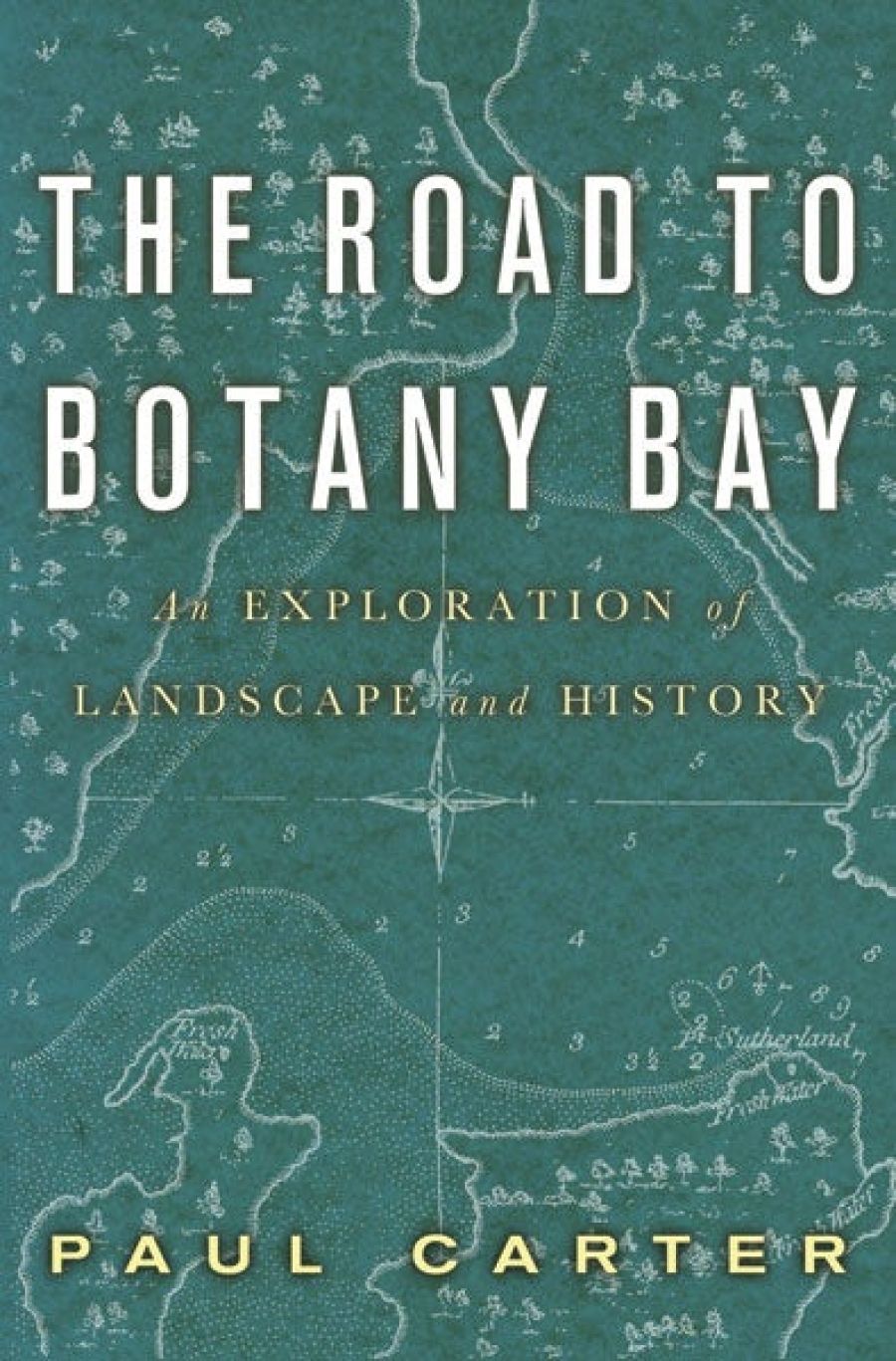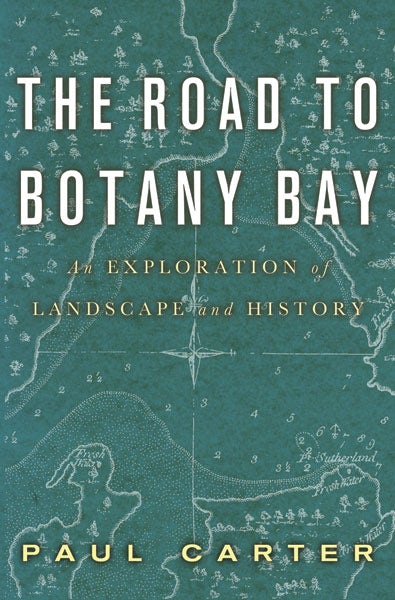
- Free Article: No
- Contents Category: History
- Review Article: Yes
- Article Title: All roads lead to home
- Online Only: No
- Custom Highlight Text:
Forty thousand is the square of two hundred years, but such dark socio-mathematics are not commensurate with Paul Carter’s idealistic account of spatial history in Australia. His exploration of exploration stresses the imaginative, or perhaps delusory, processes through which the explorers named, described and fantasised into being narratives about Australia, systems of geo-vital meaning that have conditioned much in white Australians today.
- Book 1 Title: The Road to Botany Bay
- Book 1 Biblio: Faber, $29.95 hb, 384 pp
- Book 1 Cover Small (400 x 600):

- Book 1 Cover (800 x 1200):

For the most of the book, repression, exploitation and class conflict seem a marginal presence as Carter traces the intriguing patterns of Major Mitchell’s personal contradictions, Cook versus Banks, or Flinders names a Gulf. The analysis is necessarily fine-toothed and seems to permit little space, for broader spatio-economic jostling, squatter versus selector, trooper contra worker, white above all against black.
Apart from that lack — and also emphasising it — this is in many ways an excellent book. It has a thoroughly refreshing sense of looking again at a topic: not simply the refreshment of innovation, but a penetrative draught of new explanations. At length and with fine effect Carter distinguishes between the practices of Cook and Banks, the creative explorer and the static discoverer. Cook’s imagination, Banks’ empirical lust, they set up a dialectical structure of relations that Carter pursues through other explorers, relating their patterns of thought consistently to the creative constructions they shaped into their ambience. He mixes together specific detail and theoretical speculation, but however high-flown and initially tenuous seeming, his arguments are resolved in interesting and often thoroughly convincing ways.
Particularly convincing on the ways in which explorations were self- referential and so self-validating: plains that were not plains seemed so to those desiring plains, relieving rivers imagined into being from a chain of ponds, mountains used as beacons to non-existent landfalls and as highpoints of self-projection, such as Mount Misery, Mount Deception. Carter’s own explorative reconstruction reveals a usually unconsidered human semiosis of the land and its language.
Close observation and careful thought are evident strengths of Carter’s method. He has read very widely, and in deeply varied sources— letters, diaries, local papers. Any historian can do that, and some have, though not many have matched Carter’s burrowing energy. But very few have been as well equipped in conceptual terms. Although he mercifully does not make a meal of it. Carter is clearly an adept in the mysteries of theory, that cave painting of modem academicism. Hence no doubt the hostile and intellectually shoddy reception by Clive James in the London Review of Books, and the clumsily negative one by Peter Porter in the Times Literary Supplement. To them, Carter’s discourse is a disruptive force. He is indeed a post-modernist, but, and here lies the threat, neither playful nor incomprehensible.
Much of his mindset comes out of notions of the constitutive role of culture, of writing as creation, reading as reconstruction and the shaping of a world of quasi-certainty through the frail filiations of culture. But that system alone does not always make for strong analysis, indeed it often, as in the Yale versions, seems little more than a supercharged and solipsistic form of old new criticism.
Carter adds a third strength, one surprisingly rare in the consideration of early Australian white culture, a thorough grasp of the philosophical and particularly epistemological notions underlying cultural thought at the time of settlement. While the modems from Derrida to Benjamin in form Carter’s own perceptions, his grasp of the world views of Hume and Linnaeus provides great strength, particularly for the early chapters which deal with more scientific aspects of thought.
Some of this analysis is quite gripping. The fabled Major Mitchell, at once a meticulous surveyor, topographical fantasist, and aggressive personality is not shown as a physically fragmented personality, but as combining inherent elements of a spatially attuned ego complex. Elsewhere, the construction of Melbourne, literal and conceptual, without a city centre but with many mercantile intersections, is a topic delicately teased out, and all the better for being on the brief, crisp side.
Sometimes this book does read like a weighty thesis rather than a brisk argument, but the quality of the thought sustains its divagations. In particular almost all of the lengthy quotations and detailed references are golden, not so much for Banksian collecting as for Cook-like projection in a curve that reaches the present, and that might with good fortune even condition some of the local sociohistorical writing yet to come.
One area in which Carter’s structures might in the future be developed is in the context of literary and folkloric projection. He does deal intriguingly with explorer’s diaries in the context of Boswell’s writing as a pre-existing piece of self-construction, but he nowhere engages with the literature of travel and its traditions, dominant in the novels and journalism that so many must have lead. If there is much more to do in these areas, especially poetry and novel, no discredit to Carter for leaving that. His book is full of insights, honourable intellectual labour, and more than that, it is imbued with a sense of the creative role of the intellectual in society. It is no accident that Walter Benjamin is a recurring presence in moments of modem theory.
Which, to return to a negative like so many explorers, makes it the more surprising that the material sphere is so discreetly avoided: always implied and possible, it is almost never confronted. In part that is because of Carter’s evangelizing emphasis on the formative force of cerebrality, but it is also a recurrent restriction of the impact of his book.
He does not go on to develop the human politics of the imaginatively processed world. Yet the mental structure rests on and itself consistently encounters the fact that people were imprisoned, that aboriginal possessions were appropriated, that the imaginative projections Carter so powerfully explores and describes (acting as Cook and Banks at once) operate in and make determinations upon a real society.
By remaining at the cerebral level, Carter’s interpretations construct their own delusory discourse, and so resist the evaluative demands they would face if projected to their material implications. His great theoretical strength and admirably detailed research make it all the more important to see the tangible impact on people of the web of self-referring origin and legends that Carter has so brilliantly found suspended among white Australian topography and its ideological inaugurations.


Comments powered by CComment